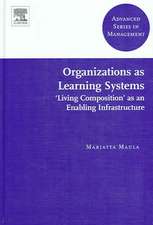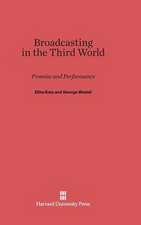Information Management – Setting the Scene: Perspectives on Information Management
Autor Ard Huizing, Erik De Vriesen Limba Engleză Hardback – 6 noi 2007
* Written by leading international scholars and industry experts
* Presents cutting edge innovative research material on information management
* Covers past, present and future trends and critically examines the assumptions underlying information management
Preț: 778.98 lei
Preț vechi: 1011.66 lei
-23% Nou
Puncte Express: 1168
Preț estimativ în valută:
149.10€ • 162.02$ • 125.33£
149.10€ • 162.02$ • 125.33£
Carte tipărită la comandă
Livrare economică 21 aprilie-05 mai
Preluare comenzi: 021 569.72.76
Specificații
ISBN-13: 9780080463261
ISBN-10: 0080463266
Pagini: 372
Ilustrații: Illustrations
Dimensiuni: 187 x 262 x 27 mm
Greutate: 0.76 kg
Editura: Emerald Publishing
Seria Perspectives on Information Management
ISBN-10: 0080463266
Pagini: 372
Ilustrații: Illustrations
Dimensiuni: 187 x 262 x 27 mm
Greutate: 0.76 kg
Editura: Emerald Publishing
Seria Perspectives on Information Management
Public țintă
This volume is targeted at information practitioners, academic researchers and higher education teachersCuprins
Editorial Board (2007). Perspectives on Information Management: Introduction to the Book Series.
1.Vries, E.J. de and Huizing, A. (2007). Information Management: Setting the Scene.
2.Maes, R. (2007). An Integrative Perspective on Information Management.
Section One. The CIO before ICT
Introduction
3.Black, A. (2007). The ‘information officer’ in Britain before the age of the computer.
4.Brunt, R.M. (2007). The information officer as intelligence officer: aspects of information management in British military intelligence 1909-45.
5.Bryant, A. (2007). Information and the CIO.
Section Two. Rising above objectivism and subjectivism
Introduction
6.Huizing, A. (2007). Objectivist by default: Why information management needs a new foundation.
7.Huizing, A. (2007). The value of a rose: Rising above objectivism and subjectivism.
8.Choo, C.W. (2007). Social use of information in organizational groups.
Section Three. ICT, Strategy and Identity
Introduction
9.Introna, L.D. (2007). Thoughts on becoming (or being) technological.
10.Ilharco, F. (2007). Strategy without Theory.
11.Introna, L.D. (2007). Strategy-as-Identity: An autopoietic contribution to the IS/IT strategy debate.
12.Brigham, M. and Introna, L.D. (2007). Strategy as Hospitality, Bricolage and Enframing: Lessons from the Identities and Trajectories of Information Technologies.
Section Four. ICT (Out)sourcing
Introduction
13.Hirschheim, R. and George, B. (2007). Three Waves of Information Technology Outsourcing.
14.Willcocks, L., Lacity, M. and Cullen, S. (2007). Information Technology Sourcing: Reflections and Lessons 1991-2007.
15.Cumps, B., Dedene, G.. and Viaene, S. (2007). ICT-Outsourcing: A resource-based Information Management Perspective.
16.Dedene, G. and Heene, A. (2007). Operational Pitfalls and Opportunities in Offshore Software Development.
Section Five. Customer Oriented Innovation
Introduction
17.Segers, J., den Hertog, P. and Bouwman, H. (2007). The Organization of Innovation in Service Firms. Evidence from four Dutch Service Firms.
18.Vries, E.J. de (2007). Service Innovation and Service Positioning Strategies.
19.Wigand, R.T. (2007). Web2.0: Disruptive Technology or Is Everything Miscellaneous?
20.Slagter, R., Fielt, E. and Janssen, W. (2007). Real business in virtual worlds: First insights.
Section Six. Designing Information and Organizations
Introduction
21.Boland, R.J. (2007). Blurring the Boundaries of Information and Organization: Morphogenesis in Design.
22.Gal, U., Yoo, Y. and Lyytinen, K. (2007). Boundary Matters: Boundary Objects, Boundary Practices, and the Shaping of Organisational Identities.
23.Hovorka, D.S. and Germonprez, M. (2007). Design Theorizing: A Kantian Inquiring Approach.
24.Avital, M. (2007). Fostering Innovation through Generative Systems Design.
Authors’ biographies
1.Vries, E.J. de and Huizing, A. (2007). Information Management: Setting the Scene.
2.Maes, R. (2007). An Integrative Perspective on Information Management.
Section One. The CIO before ICT
Introduction
3.Black, A. (2007). The ‘information officer’ in Britain before the age of the computer.
4.Brunt, R.M. (2007). The information officer as intelligence officer: aspects of information management in British military intelligence 1909-45.
5.Bryant, A. (2007). Information and the CIO.
Section Two. Rising above objectivism and subjectivism
Introduction
6.Huizing, A. (2007). Objectivist by default: Why information management needs a new foundation.
7.Huizing, A. (2007). The value of a rose: Rising above objectivism and subjectivism.
8.Choo, C.W. (2007). Social use of information in organizational groups.
Section Three. ICT, Strategy and Identity
Introduction
9.Introna, L.D. (2007). Thoughts on becoming (or being) technological.
10.Ilharco, F. (2007). Strategy without Theory.
11.Introna, L.D. (2007). Strategy-as-Identity: An autopoietic contribution to the IS/IT strategy debate.
12.Brigham, M. and Introna, L.D. (2007). Strategy as Hospitality, Bricolage and Enframing: Lessons from the Identities and Trajectories of Information Technologies.
Section Four. ICT (Out)sourcing
Introduction
13.Hirschheim, R. and George, B. (2007). Three Waves of Information Technology Outsourcing.
14.Willcocks, L., Lacity, M. and Cullen, S. (2007). Information Technology Sourcing: Reflections and Lessons 1991-2007.
15.Cumps, B., Dedene, G.. and Viaene, S. (2007). ICT-Outsourcing: A resource-based Information Management Perspective.
16.Dedene, G. and Heene, A. (2007). Operational Pitfalls and Opportunities in Offshore Software Development.
Section Five. Customer Oriented Innovation
Introduction
17.Segers, J., den Hertog, P. and Bouwman, H. (2007). The Organization of Innovation in Service Firms. Evidence from four Dutch Service Firms.
18.Vries, E.J. de (2007). Service Innovation and Service Positioning Strategies.
19.Wigand, R.T. (2007). Web2.0: Disruptive Technology or Is Everything Miscellaneous?
20.Slagter, R., Fielt, E. and Janssen, W. (2007). Real business in virtual worlds: First insights.
Section Six. Designing Information and Organizations
Introduction
21.Boland, R.J. (2007). Blurring the Boundaries of Information and Organization: Morphogenesis in Design.
22.Gal, U., Yoo, Y. and Lyytinen, K. (2007). Boundary Matters: Boundary Objects, Boundary Practices, and the Shaping of Organisational Identities.
23.Hovorka, D.S. and Germonprez, M. (2007). Design Theorizing: A Kantian Inquiring Approach.
24.Avital, M. (2007). Fostering Innovation through Generative Systems Design.
Authors’ biographies




